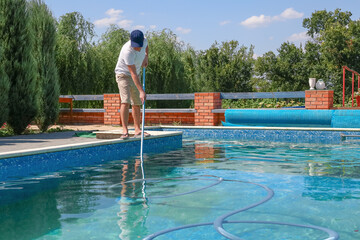A sparkling clean pool is the centerpiece of any backyard and a source of relaxation, fun, and exercise. However, maintaining a pool takes more than just filling it with water. Without proper pool cleaning, debris, algae, and bacteria can quickly turn a refreshing escape into a health risk. Understanding the essentials of pool care ensures safe water, extends the life of your equipment, and keeps your outdoor space inviting all year round.

Why Pool Cleaning Matters
Pools are exposed to leaves, insects, dust, and contaminants that affect water quality. Left unchecked, these pollutants can lead to cloudy water, algae growth, and even harmful bacteria. Beyond health, neglected pools can damage pumps, filters, and other equipment, leading to costly repairs.
Regular pool cleaning is the best way to protect your investment. Clear water enhances your swimming experience while also improving curb appeal and property value.
Essential Tools for Pool Cleaning
Having the right tools makes maintenance easier and more effective. Some must-haves include:
- Skimmer net – For removing leaves and debris from the surface.
- Pool brush – To scrub walls, ladders, and steps.
- Vacuum – Manual or automatic vacuums help clean dirt from the pool floor.
- Water testing kit – To check pH and sanitizer levels.
- Filter system – Keeps water circulating and traps contaminants.
Equipped with these, you can tackle most routine cleaning tasks confidently.
Step-by-Step Guide to Pool Cleaning
1. Skim the Surface Daily
Floating leaves, insects, and debris should be removed regularly with a skimmer net. Daily skimming prevents materials from sinking to the bottom and makes water appear instantly clearer.
2. Brush Walls and Tiles
Algae and dirt often cling to pool walls, steps, and tile lines. Brushing these surfaces once or twice a week prevents buildup and keeps surfaces smooth and clean.
3. Vacuum the Floor
Even with skimming and brushing, dirt settles at the bottom. Vacuuming once a week removes debris and ensures balanced water circulation. Some homeowners choose automatic vacuums for convenience.
4. Clean and Maintain Filters
Your pool’s filter is essential for trapping dirt and keeping water clear. Cartridge, sand, and diatomaceous earth filters all need regular cleaning or backwashing. A clogged filter reduces efficiency and may cause cloudy water.
5. Balance the Water Chemistry
Testing and balancing pool water chemistry is crucial. Aim for a pH between 7.2 and 7.6, with proper chlorine or sanitizer levels to keep bacteria at bay. Balanced water prevents irritation, algae growth, and scale buildup.
6. Shock the Pool Periodically
Shocking involves adding a higher dose of chlorine or sanitizer to kill bacteria and organic matter. It’s especially useful after heavy use, storms, or if the water looks cloudy. Shocking once every one to two weeks keeps the pool fresh and healthy.
7. Check Water Levels
Proper water levels keep the pump and filter working efficiently. Too low, and the pump may get damaged. Too high, and the skimmer won’t work properly. Maintaining the right balance ensures smooth operation.
Preventing Common Pool Problems
Regular cleaning reduces the risk of common issues, but prevention is just as important.
- Algae Growth – Prevent by brushing and keeping sanitizer levels steady.
- Cloudy Water – Caused by poor filtration or unbalanced chemicals.
- Stains and Scale – Prevent by scrubbing surfaces and monitoring water hardness.
- Pests and Debris – Use a pool cover when not in use to reduce contamination.
Seasonal Pool Cleaning Tips
Spring Opening
After winter, remove the pool cover carefully, clean any debris, and shock the water. Inspect equipment for damage before starting the season.
Summer Care
During peak swimming season, cleaning should be more frequent. Test water chemistry two to three times per week and skim daily. With more swimmers, extra care ensures safe water.
Fall Maintenance
Falling leaves create more debris, so skimming and vacuuming become essential. Prepare the pool for winter by lowering the water level if necessary and cleaning thoroughly.
Winterizing
In colder climates, winterizing protects your pool from damage. This includes draining water from pipes, adding winter chemicals, and covering the pool securely.
Health and Safety Benefits of a Clean Pool
Beyond aesthetics, a clean pool supports better health. Clear, sanitized water prevents bacteria, skin irritation, and eye discomfort. It also makes swimming safer by ensuring visibility and reducing slipping hazards around slimy surfaces.
Additionally, a well-maintained pool creates a more enjoyable environment for relaxation, exercise, and family gatherings. Swimming in clean water enhances the experience and allows you to enjoy your pool without worry.
Eco-Friendly Pool Cleaning Practices
Many pool owners are adopting eco-friendly cleaning methods to reduce chemical use and water waste. Using natural alternatives, solar covers, and energy-efficient pumps can minimize the environmental impact. Reusing filtered water for landscaping also helps conserve resources.
Pool cleaning is more than just an occasional chore—it’s an essential part of responsible pool ownership. With regular skimming, brushing, vacuuming, and chemical balancing, you can maintain crystal-clear water that is both safe and inviting. Seasonal care and preventive measures ensure your pool stays in top shape all year long.
By keeping up with maintenance, you not only extend the life of your pool but also create a beautiful, relaxing space for family and friends. A clean pool is a healthier, safer, and more enjoyable pool, making every swim a refreshing experience.